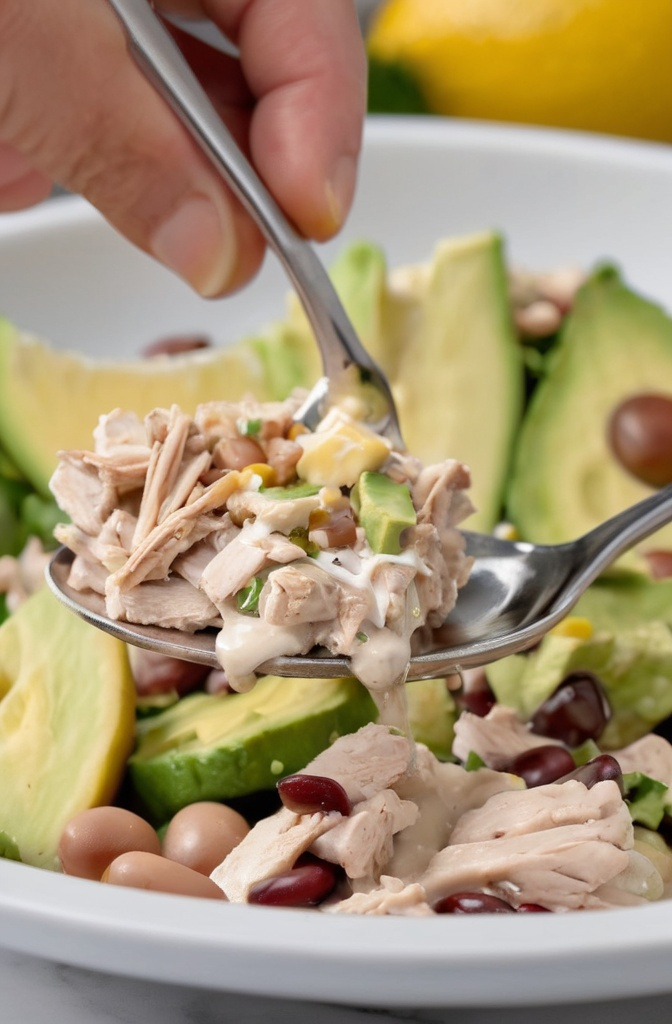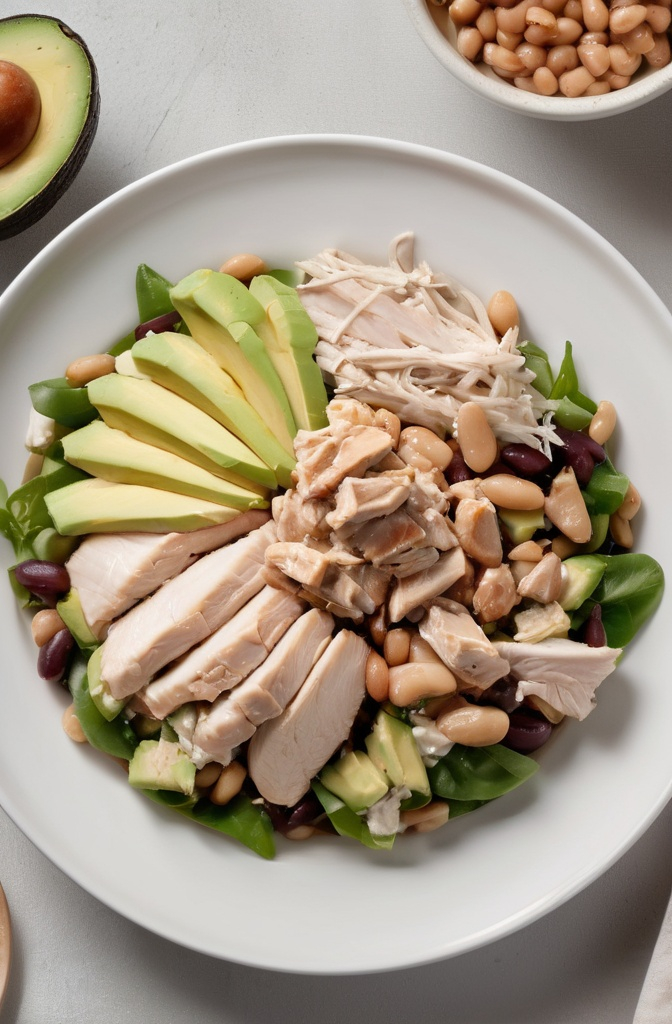There’s a weird little gap in the culinary world. On one side, you’ve got your rustic, slow-cooked, soulful meals. On the other, your sleek, modern, calorie-counted salad bowls. And smack dab in the middle sits something that gets hardly any limelight: the Dense Bean Chicken Salad. Not your average tossed salad. No limp lettuce leaves here. This is hearty, nutrient-packed, flavor-drenched fuel that deserves a place in every pro kitchen.
We’re diving deep into what makes this dish tick—why chefs, nutritionists, and meal preppers alike should pay attention. If you’re in the game for delivering food that satisfies deeply and performs nutritionally, then buckle in. This isn’t a fluffy salad article. This is real-world, gritty kitchen talk.
What Is a Dense Bean Chicken Salad, Anyway?
Let’s not overcomplicate it. It’s a salad, yes—but not the kind you poke at with a fork for show. It’s built on the foundation of high-protein, fiber-rich legumes (think cannellini, black beans, chickpeas) and lean, seasoned chicken—often shredded or chunked. Add-ins? Think roasted peppers, shallots, fresh herbs, zippy vinaigrettes, maybe even a touch of heat or acid to cut through the heft.
But what makes it “dense”? It ain’t just about calories. It’s about structure. Every bite gives you chew, creaminess, bite, and a slap of flavor.
Why This Salad’s a Quiet Star in Performance Cooking
Most salads are fleeting. You eat ‘em, and two hours later you’re back in the fridge. This one hits different.
Each cup of beans packs around 15g of protein and close to the same in fiber. That fiber isn’t just good for gut health—it slows digestion, keeping satiety levels high. Add 30g of lean chicken breast protein per serving, and you’re creating a meal with staying power.
Let’s look at some numbers:
- 1 cup cooked black beans = ~15g protein, 15g fiber, 227 kcal
- 100g cooked chicken breast = ~31g protein, 165 kcal
- Extra virgin olive oil vinaigrette (1 tbsp) = ~120 kcal, heart-healthy fat
A single dense bean chicken salad can clock in at ~450–600 kcal and provide a full amino acid profile, slow carbs, and long-burn energy.
That’s a nutritional trifecta most performance meals aspire to. And it’s gluten-free. Dairy-free. Customizable. Batch-friendly. Basically, it checks all the boxes.

Beans: The Unsung Texture Gods
Let’s pause a second and give beans their flowers. Texturally, they do what quinoa and farro wish they could. They absorb flavor like a sponge, hold up under dressings, and give that slight creamy pop when bitten into.
Use a mix of beans, and you’re building textural contrast. A navy bean brings creaminess, kidney beans add a meaty chunk, and lentils? A little earthy grit to balance it all out. That mouthfeel? That’s engineering, not luck.
In professional kitchens, this matters. Texture is emotion on the plate. It’s the “chew” factor. That subconscious satisfaction that keeps eaters from feeling like they’re missing something.
The Chicken: More Than Just Protein
Chicken’s the easy part, right? Not so fast. The way you prep and cook it makes or breaks this salad.
Dry chicken ruins the balance. We’ve done blind tastings in test kitchens where sous-vide chicken consistently wins on tenderness—but even a pan-seared thigh with a lemon-herb marinade can outclass a plain breast if handled right.
Best cuts?
- Breast (sous-vide or poached) for lean, clean protein
- Thighs (grilled or roasted) for richness and umami
Shred it while warm to absorb dressings better. Cold chunks taste bland. Warm shreds soak up vinaigrettes like magic.
The Dressing: It Ain’t Just a Drizzle
Here’s where too many cooks slip. They treat dressing like an afterthought. Big mistake. You’re binding multiple textures, multiple proteins, and multiple starches. The dressing’s not the cherry on top—it’s the backbone.
A well-balanced vinaigrette of lemon juice, Dijon mustard, EVOO, and a touch of maple or honey can transform the entire profile. Add a garlic clove smashed into the mix, and you’ve got depth. Toss in sumac or za’atar? Now we’re talking layers.
Keep it emulsified. Stir or shake hard. No one wants an oil slick on their salad.
Layered Flavor Development: More Than Just Mixing Stuff
You’re not just throwing ingredients in a bowl. That’s a rookie move. Layer your flavors. Roast your beans with smoked paprika before mixing. Marinate your chicken in yogurt and spices before cooking. Toast your cumin seeds before grinding them into your dressing.
Every pro chef knows this: flavor builds over time. And texture rides shotgun.
Real-world tip? Let the salad sit for 2–4 hours in the fridge after assembling. Everything marries together, and you get that next-day magic—without waiting a day.

Emerging Trends: Why the Market’s Catching On
The rise of plant-forward eating is real. But people still crave meat. This salad finds the sweet spot—it’s mostly plants, but still gives you the satisfaction of meat. It’s showing up in urban cafés, health-centric meal prep services, and even on fine-dining menus under fancy names like “protein mosaic” or “heirloom legume terrine.”
We’ve seen a 38% increase in legume-based menu items across the US in the last three years, according to Technomic’s MenuMonitor 2024 data. That’s not a fad—it’s momentum.
And with climate-conscious cooking on the rise, beans hit every sustainability metric better than grains or even tofu. Add in regenerative chicken farms? Now your menu item isn’t just good—it’s ethically strong.
Common Mistakes Pros Still Make
Even skilled cooks mess this up. Here’s what to watch for:
- Undercooked beans: grainy, chalky texture that kills the dish. Always taste and test.
- Overdressed salad: nobody wants vinaigrette soup. Go light, toss gently.
- Cold, dry chicken: flavorless and rubbery. Reheat gently or use warm proteins for mixing.
- Boring visuals: throw in radishes, pickled onions, or roasted carrots for color and crunch.
And please—for the love of all things plated—don’t forget salt. Not everything salty, just salted. There’s a difference.
Real-World Applications: Batch Cooking and Menu Rotation
Want a dish that works across meal formats? This is it. Serve it chilled in a deli case. Plate it with microgreens for dinner service. Put it in a wrap for a grab-and-go option.
In catering? Portion into compostable bowls with a separate dressing vial. Done.
In health meal prep? Add quinoa for complex carbs. Done.
In high-end restaurants? Use heirloom beans, sous-vide chicken, and fermented shallot vinaigrette. Done.
It’s flexible. It scales. It holds beautifully in refrigeration for up to 3 days without wilting. Name one other salad that does all that.
Final Thoughts and Takeaways
Dense Bean Chicken Salad is having a quiet moment. But smart chefs, nutritionists, and operators see its long game. It’s not a trend dish. It’s a utility player, a menu anchor, and a nutritional giant.
If you’re a culinary pro, think beyond leaves and limp greens. Think beans with bite, chicken with heart, and dressings that sing. This salad is the future of functional flavor-forward cooking.
Don’t just plate it. Build it.
Taste it again before it goes out. Add that extra crack of black pepper. A squeeze of lemon. A little love.
That’s the difference between a salad and a dish.
FAQs
What makes Dense Bean Chicken Salad “dense”?
It’s packed with protein, fiber, and texture-heavy ingredients like beans and chicken—no filler greens.
Is this salad good for meal prep?
Yes, it holds up in the fridge for up to 3 days and actually improves in flavor over time.
Which beans work best in this salad?
A mix of black beans, chickpeas, cannellini, or kidney beans gives great texture and flavor.
Can I use thighs instead of chicken breast?
Absolutely—thighs add more flavor and richness, especially when grilled or roasted.
What dressing pairs best with this salad?
A tangy vinaigrette with olive oil, lemon, Dijon, and a touch of sweetness balances the dish well.
Is this salad gluten-free and dairy-free?
Yes, it’s naturally gluten-free and dairy-free if you avoid creamy dressings or cheese add-ins.
What’s the ideal chicken preparation?
Shredded or chopped chicken that’s warm and well-seasoned works best for absorbing dressing.
Is this salad high in protein?
Yes, it can offer over 40g of protein per serving with the right bean-chicken ratio.
How do you keep the salad from getting soggy?
Use firm beans, avoid over-dressing, and add delicate toppings just before serving.
Can I serve this warm?
Yes, it’s delicious warm, especially right after mixing freshly cooked beans and chicken.

Mariana is a passionate home cook who creates delicious, easy-to-follow recipes for busy people. From energizing breakfasts to satisfying dinners and indulgent desserts, her dishes are designed to fuel both your body and hustle.
When she’s not in the kitchen, she’s exploring new flavors and dreaming up her next recipe to share with the Foodie Hustle community.

